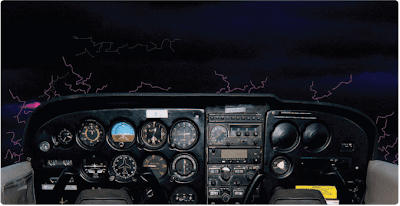Inadvertent Thunderstorm Encounter
A pilot should avoid flying through a thunderstorm of any intensity. However, certain conditions may be present that could lead to an inadvertent thunderstorm encounter. For example, flying in areas where thunderstorms are embedded in large cloud masses may make thunderstorm avoidance difficult, even when the aircraft is equipped with thunderstorm detection equipment. Therefore, pilots must be prepared to deal with an inadvertent thunderstorm penetration. At the very least, a thunderstorm encounter subjects the aircraft to turbulence that could be severe. The pilot and passengers should tighten seat belts and shoulder harnesses, and secure any loose items in the cabin.
As with any emergency, the first order of business during an inadvertent thunderstorm encounter must be to fly the aircraft. The pilot workload is heavy; therefore, increased concentration is necessary to maintain an instrument scan. If a pilot inadvertently enters a thunderstorm, it is better to maintain a course straight through the thunderstorm rather than turning around. A straight course minimizes the amount of time in the thunderstorm, and turning maneuvers only increase structural stress on the aircraft.
Reduce power to a setting that maintains a speed at the recommended turbulence penetration speed as described in the Pilot’s Operating Handbook/Airplane Flight Manual (POH/ AFM), and try to minimize additional power adjustments. Concentrate on maintaining a level attitude while allowing airspeed and altitude to fluctuate. Similarly, if using the autopilot, disengage the altitude hold and speed hold modes, as they only increase the aircraft’s maneuvering—thereby increasing structural stress.
During a thunderstorm encounter, the potential for icing also exists. As soon as possible, turn on anti-icing/deicing equipment and carburetor heat, if equipped. Icing can be rapid at any altitude and may lead to power failure and/or loss of airspeed indication.
Lightning is also present in a thunderstorm and can temporarily blind a pilot. To reduce this risk, turn up flight deck lights to the highest intensity, concentrate on the flight instruments, and resist the urge to look outside.
Inadvertent Icing Encounter
Because icing is unpredictable in nature, pilots may find themselves in icing conditions even though they have done everything practicable to avoid it. In order to stay alert to this possibility while operating in visible moisture, pilots should monitor the outside air temperature (OAT).
The effects of ice on aircraft are cumulative—thrust is reduced, drag increases, lift lessens, and weight increases. The results are an increase in stall speed and a deterioration of aircraft performance. In extreme cases, two to three inches of ice can form on the leading edge of the airfoil in less than 5 minutes. It takes only 1⁄2 inch of ice to reduce the lifting power of some aircraft by 50 percent and increases the frictional drag by an equal percentage.
A pilot can expect icing when flying in visible precipitation, such as rain or cloud droplets, and the temperature is between +02 and –10° Celsius. When icing is detected, a pilot should do one of two things, particularly if the aircraft is not equipped with deicing equipment: leave the area of precipitation or go to an altitude where the temperature is above freezing. This “warmer” altitude may not always be a lower altitude. Proper preflight action includes obtaining information on the freezing level and the above-freezing levels in precipitation areas.
If neither option is available, consider an immediate landing at the nearest suitable airport. Even if the aircraft is equipped with anti-icing/deicing equipment, it is not designed to allow aircraft to operate indefinitely in icing conditions. Antiicing/ deicing equipment gives a pilot more time to get out of the icing conditions. Report icing to ATC and request new routing or altitude. Be sure to report the type of aircraft, and use the following terms when reporting icing to ATC:
- Trace. Ice becomes perceptible. Rate of accumulation is slightly greater than sublimation. Anti-icing/deicing equipment is not utilized unless encountered for an extended period of time (over 1 hour).
- Light. The rate of accumulation may create a problem if flight is prolonged in this environment (over 1 hour). Occasional use of anti-icing/deicing equipment removes/prevents accumulation. It does not present a problem if anti-icing/deicing equipment is used.
- Moderate. The rate of accumulation is such that even short encounters become potentially hazardous and use of anti-icing/deicing equipment or flight diversion is necessary.
- Severe. The rate of accumulation is such that antiicing/ deicing equipment fails to reduce or control the hazard. Immediate flight diversion is necessary.
Early ice detection is critical and is particularly difficult during night flight. Use a flashlight to check for ice accumulation on the wings. At the first indication of ice accumulation, take action to get out of the icing conditions. Refer to the POH/ AFM for the proper use of anti-icing/deicing equipment.
Precipitation Static
Precipitation static, often referred to as P-static, occurs when accumulated static electricity is discharged from the extremities of the aircraft. This discharge has the potential to create problems for the instrument pilot. These problems range from the serious, such as erroneous magnetic compass readings and the complete loss of very high frequency (VHF) communications to the annoyance of high-pitched audio squealing and St. Elmo’s fire. [Figure 1]
 |
| Figure 1. St. Elmo’s Fire is harmless but may affect both communication and navigation radios, especially the lower frequencies such as those used on the automatic direction finding (ADF) |
Precipitation static is caused when an aircraft encounters airborne particles during flight (e.g., rain or snow) and develops a negative charge. It can also result from atmospheric electric fields in thunderstorm clouds. When a significant negative voltage level is reached, the aircraft discharges it, which can create electrical disturbances. This electrical discharge builds with time as the aircraft flies in precipitation. It is usually encountered in rain, but snow can cause the same effect. As the static buildup increases, the effectiveness of both communication and navigation systems decreases to the point of potential unusability.

